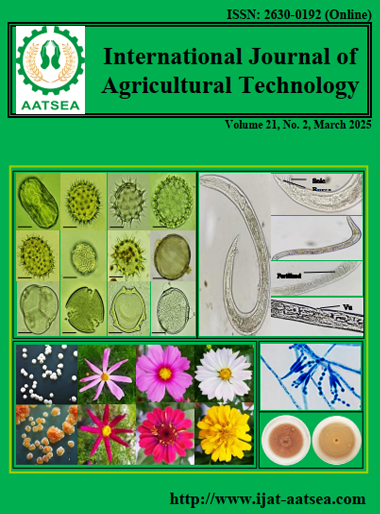Potential of snake fruit (Salacca zalacca) cultivars on product quality for fermented vinegar beverages
Main Article Content
Abstract
Results showed that using naturally vinegar fermentation methods was not successful in two of the cultivars, Mo and Sumalee. Although Noen Wong did succeed in the naturally fermenting vinegar, the final product had undesirable flavor characteristics. Vinegar fermentation from all three snake fruit cultivars using the yeast, Saccharomyces cerevisiae and the Acetobacter pasteurianus bacteria, yielded the desired product of vinegar beverage. A higher level of total phenolic content was detected in the vinegars produced from Noen Wong cultivar, while those produced from Mo cultivar exhibited the highest levels of antioxidant activity. Sensory evaluation based on the 9-point hedonic scales and tested with 30 panelists, showed that vinegars produced from Mo and Sumalee cultivars showed the highest overall preference, with an average score of 6.07-6.13, which indicated a medium pleasant level of the vinegar preference. This study concluded that the Mo cultivar is found to be most suitable for making fermented vinegar beverage, however, it is recommended that the color characteristics could be improved.
Article Details

This work is licensed under a Creative Commons Attribution-NonCommercial-NoDerivatives 4.0 International License.
References
Choorak, U. (2024). The appropriate technology developing for Salak (Salacca zalacca) production to income stability and food access in Phatthalung province. XVth Hatyai National and International Conference, Songkhla, Thailand, 582-596.
Deeraksa, S. (2005). A comparative study of mangosteen wine quality using natural microbial and pure yeast culture. (Master thesis). Maejo University, Chiang Mai, Thailand.
Department of Medical Sciences (2016). Standard Methods for food Analysis, Volume IV. Nonthaburi: Agricultural Cooperative Community Printing House. 218 p.
Dewanto, V., Wu, X., Adom, K. K. and Liu, R. H. (2002). Thermal processing enhances the nutritional value of tomatoes by increasing total antioxidant activity. Journal of Agricultural and Food Chemistry, 50:3010-3014.
Haruenkit, R., Poovarodom, S., Leontowicz, H., Leontowicz, M., Sajewicz, M. and Kowalska, T. (2007). Comparative study of health properties and nutritional value of durian, mangosteen, and snake fruit: Experiments in vitro and in vivo. Journal of Agricultural and Food Chemistry, 55: 5842-5849.
Johnston, C. S., Quagliano, S. and White, S. (2013). Vinegar ingestion at mealtime reduced fasting blood glucose concentrations in healthy adults at risk for type 2 diabetes. Journal of Functional Foods, 5:2000-2011.
Korsten, L. (2006). Advances in control of postharvest diseases in tropical fresh produce. International Journal of Postharvest Technology and Innovation, 1:48-61.
Lestari, R. and Ebert, G. (2002). Salak (Salacca zalacca (Gaertner.) Voss.) - The snake fruit from Indonesia preliminary results of an ecophysiological study. In conference on International Research on Food Security Natural Resource Management and Rural Development, Deutcher Tropentag 2002:9-11 October, Witzenhausen, Germany.
Manurung, V. H., Djarkasi, G. S. S., Langi, T. M. and Lalujan, L. E. (2013). Analysis the physic characteristic and chemical characteristic of Pangu Snake Fruit (Salacca Zalacca) with waxing while in storage place. Retrieved from https://ejournal.unsrat.ac.id/index.php/cocos/article/view/2493.
Rangsiruji, A., Pongpawe, T. and Dondakul. (2006). Karyotypes of some Salacca in Thailand and Indonesia. Srinakharinwirot Science Journal, 22:48-61.
Phattharatham, S. (2011). Salacca Varieties of Thai Wisdom. Agriculturemag, 24:69-74.
Prampramot, J. (2022). How are the different in taste among the Salacca wallichiana (Sour and sweet), and the Salacca zalacca (Noen Wong and Sumalee?. Retrieved from https://blog.wu.ac.th/archives/6850
Saithong, P. and Permpool, J. (2019). Health benefits of fermented vinegar. Food Journal, 49:17-24.
Supriyadi, S., Suzuk, M., Wu, S., Tomita, N., Fujita, A. and Watanabe, N. (2003). Biogenesis of volatile methyl esters in snake fruit (Salacca edulis, Reinw) cv. Pondoh. Bioscience, Biotechnology, and Biochemistry, 67:1267-1271.
Wjaya, C. H., Ulrich, D., Lestar, i R., Schippel, K. and Ebert, G. (2005). Identication of potent odorants in different cultivars of snake fruit [Salacca zalacca (Gaert.) Voss] using gas chromatography-olfactometry. Journal of Agricultural and Food Chemistry, 53:1637-1641.


